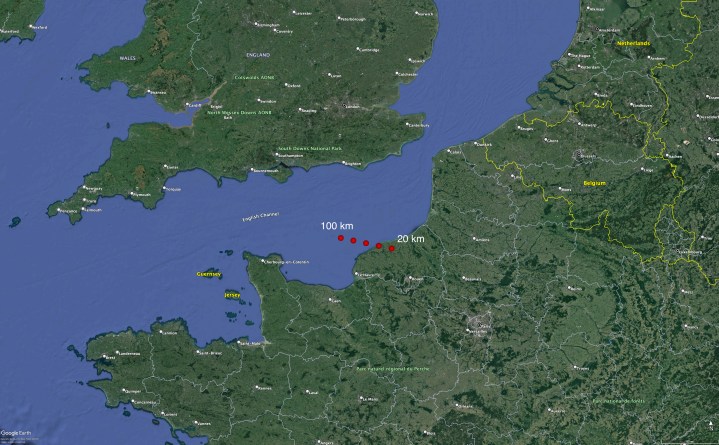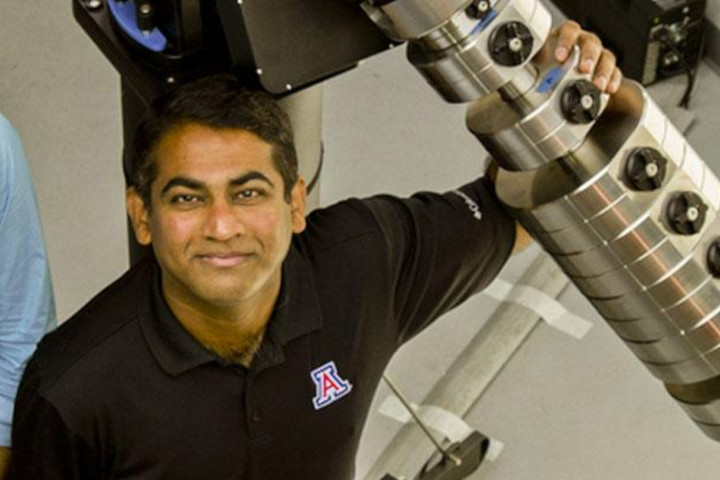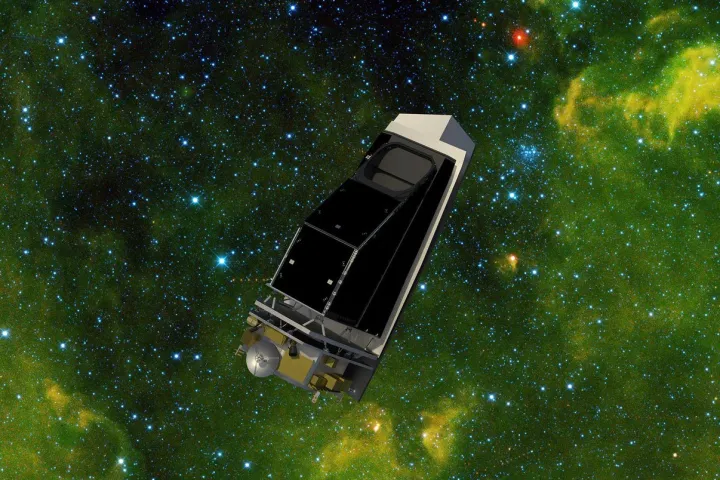
There are few cosmological concepts which have gripped the public — and Hollywood — more tightly than the idea of an incoming asteroid. Huge chunks of rock headed for Earth with the potential to destroy the planet — it’s a terrifying thought.
Fortunately we’re getting better than ever at spotting near-Earth objects that could pose a danger, and astronomers have been able to predict small impacts before they happen.
But spotting something in the sky is one thing. Working out what that something is, and whether it’s a potential danger, is a different challenge entirely. We wanted to know what it takes to determine whether an asteroid is dangerous or not, so we spoke to some of the researchers working on the front lines of planetary defense to find out.
A mathematical problem
Once an asteroid has been detected, we next need to know its trajectory — whether it will be coming close to Earth’s orbit, and whether it will be intersecting that orbit at the time Earth is passing by. The task of determining a trajectory falls to NASA’s Center for Near-Earth Object Studies, or CNEOS. Heading up the center is Paul Chodas, who leads a group of mathematicians who take observations from telescopes and calculate objects’ trajectories.
“It’s all a mathematical problem,” Chodas told Digital Trends — but it’s not a simple one. You can track an object’s motion with multiple observations of it, but that doesn’t tell you how far away it is.
“It’s complex, because you need to have precision models of the solar system: the Earth’s position, the sun’s position especially, the moon,” Chodas said. “For longer-term predictions, you need to know where all the planets are because they all have an effect on the motion of asteroids.”

That’s why more data is always helpful — either having multiple observations of an object on the same night, or having multiple observations from different observers.
Fortunately, the immutable laws of physics help with that. “We run the coordinates through our software, and gradually the physics laws of gravity start to constrain that trajectory,” Chodas explained.
The number of objects is skyrocketing.
There will always be a degree of uncertainty over trajectories, but that uncertainty shrinks with more data. The more observations that CNEOS has, the more accurately it can predict an object’s path. The lower the uncertainty, the further into the future a trajectory can be calculated.
The group requires at least four observations over at least an hour. While it is technically possible to calculate a trajectory with just three observations, typically the center will get around 12 observations of a new object before it is announced by the International Astronomical Union’s Minor Planet Center and given a name. That makes it an official minor body.
It’s not just asteroids
When you think about objects potentially impacting the planet, your mind likely goes to asteroids first. These chunks of rocks are by far the most common near-Earth objects, but they aren’t the only ones.
Other potentially dangerous objects include comets, which are made of ice and rock, and which could also cause widespread damage if they impacted the planet.

While most asteroids come from the main asteroid belt between Mars and Jupiter, most comets come from the Kuiper Belt or from the Oort cloud far beyond the orbit of Neptune. So comets often approach Earth at different angles than asteroids, though the principles for calculating their trajectories are the same.
The problem, Chodas explained, is that comets go through a process called outgassing as they approach the sun. As they get warmer, some of their ice sublimates into gases, creating the comets’ distinctive tails. And these gases can affect the comets’ trajectories, making those trajectories more uncertain. Researchers call this non-gravitational acceleration, as the jets from comets will affect their motion.
“Comets are more difficult to predict, especially a newly discovered comet where you don’t have any historical data on how the non-gravitational effects behave on previous passages near the sun,” Chodas said.
Less than 1% of near-Earth objects are comets, so asteroids are far more common. But comets are tricky, and we can’t overlook them when it comes to planetary defense.
Automating the process
One of the challenges of this work is that there are a lot — really, a lot — of small objects in the solar system, so trying to manually calculate trajectories for each would be untenable.
“The number of objects is skyrocketing,” Chodas said, “so a lot of this is automated.”
Indeed, the main database of small solar system bodies now contains more than 1.3 million objects. Historically, trajectories were calculated manually, but CNEOS now uses computers to automate the process.
Time is your best friend when it comes to planetary defense.
There are two tools the center uses. The Scout system can check for possible impactors within just a few minutes, and is used for newly detected and unconfirmed objects. Another tool, Sentry, runs predictions on tens of thousands of objects while looking for the possibility of impactors in the next hundred years. These far-future predictions have larger uncertainties, but the idea is to flag up any objects that could come potentially close to Earth’s orbit.
If an object is a potential threat to Earth, it is flagged and sent to the NASA Planetary Defense Coordination Office, which coordinates global planetary defense efforts.
Characterizing an object
So now we know where an asteroid is, and whether it’s going to come close to Earth in the next 100 years. But to know whether it’s really dangerous and how much of a threat it poses, we need to know more about the object itself: What is it made of? How dense is it? What is its shape and how fast is it spinning?
Figuring that out is the job of researchers like Vishnu Reddy, who heads up a space situational awareness research group at the University of Arizona. The group uses ground-based telescopes to observe objects like asteroids and to determine their characteristics.

There are a variety of techniques that researchers can use to get information about an asteroid. Spectroscopy can tell you what an object is made of and its grain density, while radar can reveal its diameter and shape. Thermal infrared observations can show an object’s properties such as how much light it is reflecting — which helps inform about its composition as well.
By using multiple different overlapping techniques, researchers can work out a surprising amount about an asteroid, even if it is small and far away.
This is important because the particular characteristics of an asteroid can significantly affect how potentially dangerous it is. For example, asteroids’ interior structures come in two main types: rubble piles, which are collections of small pieces that are loosely held together, and monoliths, which are solid chunks of material. Those two types will react very differently to impacts.

“We think that most smaller [near-Earth objects] are rubble piles, which means they’re loose blocks of material. They’re not mechanically held together like a solid monolith,” Reddy explained to Digital Trends. “A solid object is likely to make it to the ground. A weaker object will likely have an airburst and destroy itself higher up in the atmosphere.”
If scientists can spot a potentially dangerous object far enough in advance, they’ll have time to characterize it and predict its course. “Time is your best friend when it comes to planetary defense,” Reddy said. “You want to discover all of these objects years or decades ahead so you can predict whether they will impact the Earth.”
Are we ready?
The good news is that we’ve identified almost all of the very large asteroids that could come close to Earth, and none pose any current danger. We aren’t going to experience another dinosaur-killer-style event any time soon.
When it comes to the threat of a huge asteroid hitting us, “It’s a very low probability event,” Chodas said. “It’s really not something to lose sleep over.”
That doesn’t mean we don’t have anything to think about, however. “Having said that, we have the technology to find these — at least the 140 meter and larger — and we can address that problem over time,” Chodas continued.
The focus now is on these medium-sized asteroids — those between 140 meters and 1 kilometer in size — which wouldn’t destroy the planet, but could cause significant damage if they were to hit in a dense populated area like a city. Most objects fall into the ocean, but if we got unlucky and one happened to hit an urban area, it could be disastrous.
Upcoming missions like Near-Earth Orbit Surveyor (NEOS) will massively improve our abilities to detect these medium-sized bodies. And tests of asteroid deflection technologies like the Double Asteroid Redirection Test (DART) show that it is theoretically possible — at least if we have enough advance warning — to deflect an incoming body by crashing into it with a spacecraft.

But make no mistake, DART was an incredible achievement, but it isn’t a defense system. It did succeed in altering the course of an asteroid, but not by enough to prevent an Earth impact if it had been a real threat. (To get an idea of what would be required to deflect an asteroid, CNEOS has an online app that lets you simulate incoming asteroids and how much they would be deflected by various impacts.)
“By our calculations, you need to move something by a centimeter per second or a couple of centimeters per second, and the amount of velocity change that DART imparted was 10 times smaller than that,” Chodas said. “DART was an important experiment and we learned a lot from it,” but “that would not be enough in a real case.”
A diplomatic issue
Though we might be scientifically and technologically on track to deal with asteroid threats, one area in which we aren’t ready at all is in terms of diplomatic relationships.
“Having a global perspective on planetary defense is very, very important,” Reddy said, because we can’t think about the problem of planetary defense in terms of individual nations.
“If an asteroid were to hit another part of the world, it’s not like, ‘Oh, it’s their problem.’ The stuff that goes into the atmosphere — we breathe that stuff. The earthquakes, the wildfires, everything from the shock waves — that affects us too. A global solution is what we should invest in.”
Organizations like the International Asteroid Warning Network, or IAWN, which Reddy works with, aim to bring together a global perspective on planetary defense. But more diplomatic work is needed to coordinate a global solution to potential planetary threats.
Because while the risk of asteroid impact might seem scary and unknown, it isn’t impossible to predict. With the right technology and shared global will, we do have the potential to identify and mitigate this threat.
“It is a global problem, and we have strength in numbers,” Reddy said.




